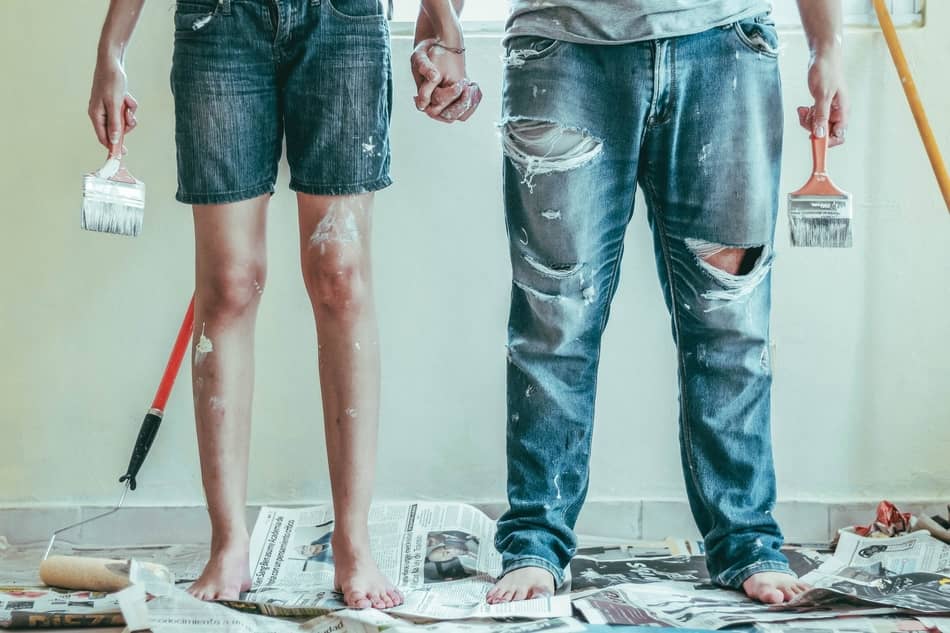I know how tricky it is to remove all the glue when stripping wallpaper. Unfortunately, it’s vital that the wallpaper glue is completely removed before you carry out anymore work. So how can you tell if all of the wallpaper glue has been removed?
In order to tell whether all the wallpaper has been removed, spray some water on the wall and let it soak in. When you run your hand over the damp wall, it should feel smooth. If the wall feels sticky or slimy, it means that there is still some glue on the wall. Ensure that all the glue is removed before painting.
If your wall still has some glue left on the surface, I’m going to take you through the steps to ensure that’s totally gone.

How to remove wallpaper glue
Wallpaper glue is often left behind on the wall when you have removed wallpaper and it leaves the wall feeling sticky which makes it impossible to paint over. Although removing wallpaper glue is a fairly simple task to do and does not require any special tools – most being able to be found around the house – it can be quite time-consuming as it is often stubborn to remove.
Equipment
You will need:
- Disposable gloves
- Spray bottle
- Towels and sponges
- Drop cloths
- Vinegar
- Wallpaper scraper
- Liquid soap
Method
There are a few steps to follow to remove the wallpaper glue:
- First of all, move all of your furniture and other items away from the wall where you’re going to be working and cover the floor with drop cloths to protect the area. Make sure that you cover all the electrical outlets and move electrical items far enough away that there is no danger of them getting wet. Get a dustbin ready to put the wallpaper in and make sure that you are wearing disposable gloves for handling the old wallpaper.
- Mix some cleaning solution in a bucket using hot water, a small amount of the liquid soap, and a teaspoon of baking soda. A handy tip is to mix the cleaning solution in several small batches as you need it, rather than all in one go so that your water will stay hot.
- Dip a sponge in the cleaning mixture and use it to rub a section of the wallpaper. The water will cause the wallpaper to soften and you can then wipe the glue off the wall as you pull the old wallpaper away. Sometimes the wallpaper doesn’t come away from the wall easily – if that happens then use the scraper to scrape it off carefully.
- Rinse the cleaning solution from the wall. If the wall now feels smooth then you can dry the area with a towel, but if it still feels sticky from the glue then repeat the step above until the wall is clear.
- If the wallpaper glue still does not come off the wall after repeating step 3 then, in a fresh bucket, mix one cup of white vinegar with hot water.
- Next, take a sponge and dip it in the new mixture, but then wring out the excess water from it, and rub the sponge over the wallpaper glue that is still on the wall.
- Wait several minutes to allow the vinegar and water mixture to soak into the glue before gently scraping it off the wall. Continue to repeat until the wall is free from wallpaper glue.
Tips
- An easier way to reach higher areas of the wall and to prevent spillages is to use a spray bottle with the solution instead of a sponge.
- If you have really stubborn wallpaper glue, then combine either one tablespoon of baking soda or four tablespoons of fabric softener to hot water and use in a spray bottle instead of the vinegar and water solution.
- Only soak a small area at a time, so that you remove the wallpaper and glue quickly while it is still wet, rather than a larger area.
- Do not use excessive amounts of cleaning solution as you will soak the drywall and damage it.
- Wallpaper glue sometimes contains toxic fungicides, so you must make sure that you dispose of the old wallpaper correctly and keep it away from children and pets.
The dangers of painting over wallpaper glue
Usually, the whole purpose of removing wallpaper is so that the wall underneath can be painted, and it is essential that all of the wallpaper glue is removed first as otherwise the paint will just peel off the wall instead of sticking to it.
The wallpaper glue that was on the wall would most likely have been water-based, and the paint that people use is also usually water-based as it has a low odour, is easy to clean, and is safe for the environment. If the two are mixed – water-based paint and water-based glue – then the glue will absorb the water that is in the paint. When this happens, the glue is reactivated.
Even though it might look ok to start with, you would eventually begin to see chips and cracks in the paint and it will begin to flake and peel off. This is caused by the glue reactivating as it prevents the paint from completely sticking to the wall, hence it will flake off and look unprofessional.
Tips for painting over glue
Sometimes, no matter how hard you try, you can never quite get rid of all of the old wallpaper glue, and your wall is left feeling sticky to the touch. In those cases, you can leave it on the wall but ensure that you use an oil-based primer before painting over it, as that way you won’t have to worry about your paint flaking off.
If you are going to be painting over wallpaper glue then it is important to use an oil-based primer first. This is because oil and water do not mix, therefore the oil-based primer creates a barrier between the glue and the paint and prevents the glue from reacting with it.
It’s often best to use an oil-based primer anyway, even if you think you have removed all of the glue, as there is always the chance that you have missed a spot or two. There would be nothing worse than having a lovely painted wall and then finding a couple of little flaky spots where you had missed a bit!
Conclusion
If you follow the steps above then you should have no problem removing the old wallpaper and glue from the wall. It can sometimes take longer than expected if the glue is particularly stubborn, especially if the wallpaper has been up for a while, but you should eventually get there.
Once you have successfully removed all of the glue from the walls, you must let them dry for around 24 hours before attempting to paint them. If they still feel a bit sticky or slimy then there is probably still some glue on them and you will need to clean them again to remove it.
It is also possible to rent a steam cleaner to help to remove the wallpaper or you could bring in a professional to do the job for you. But no matter which route you go down, the wall needs to feel smooth otherwise there is still some glue on it.
Just remember that you should always take your time when removing the glue from the walls as it is a time-consuming job that cannot be rushed.

